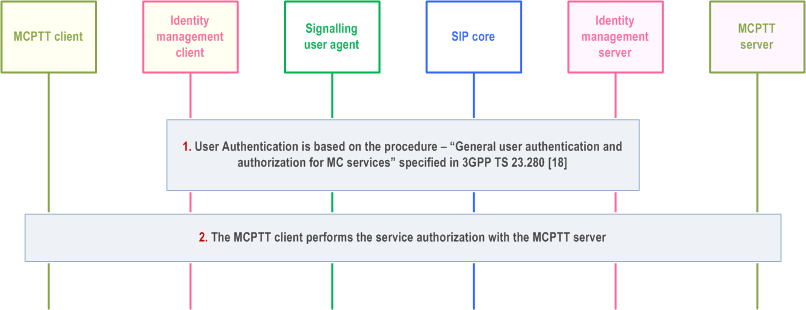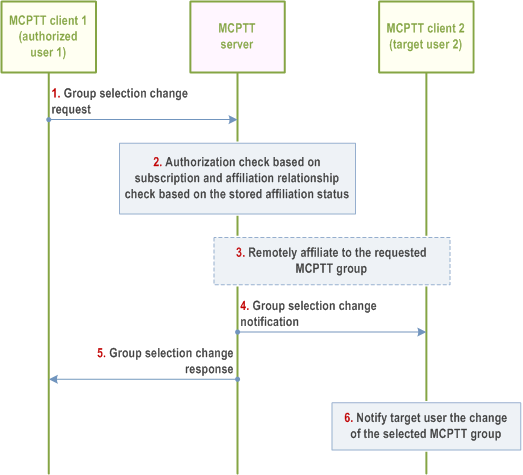Content for TS 23.379 Word version: 19.5.0
1…
7…
10…
10.5…
10.6…
10.6.2.3…
10.6.2.4…
10.6.2.5…
10.6.2.6…
10.6.2.9…
10.6.3…
10.7…
10.7.3…
10.7.5…
10.7.6…
10.9…
10.9.1.3.3…
10.9.1.4…
10.9.2…
10.10…
10.12…
10.19…
10.19.3…
10.19.3.1.4…
10.19.3.2…
10.19.3.2.4…
10.19.3.2.6…
A…
10 Procedures and information flows
10.1 MCPTT service configuration
10.2 User authentication and authorization for MCPTT service
10.3 Affiliation and de-affiliation to/from MCPTT group(s)
10.3a Activation and de-activation of/from functional alias(es)
10.4 MCPTT group selection
10.4.1 General
10.4.2 Information flows for group selection
10.4.3 Authorized user remotely changes another MCPTT user's selected MCPTT group - mandatory mode
...
...
10 Procedures and information flows p. 28
10.1 MCPTT service configuration p. 28
The MCPTT service shall support the procedures and related information flows as specified in subclause 10.1 of TS 23.280 with the following clarifications:
- The MC service client is the MCPTT client;
- The MC service server is the MCPTT server;
- The MC service ID is the MCPTT ID; and
- The MC service user profile index is the MCPTT user profile index.
10.2 User authentication and authorization for MCPTT service p. 28
A procedure for user authentication is illustrated in Figure 10.2-1. The user authentication is performed based on the procedure specified in TS 23.280.

10.3 Affiliation and de-affiliation to/from MCPTT group(s) p. 29
The MCPTT service shall support the procedures and related information flows as specified in subclause 10.8 of TS 23.280 with the following clarifications:
- The MC service client is the MCPTT client;
- The MC service server is the MCPTT server;
- The MC service group is the MCPTT group;
- The MC service ID is the MCPTT ID; and
- The MC service group ID is the MCPTT group ID.
10.3a Activation and de-activation of/from functional alias(es) |R15| p. 29
The MCPTT service shall support the procedures and related information flows as specified in subclause 10.13.4 of TS 23.280 and subclause 10.13.5 of TS 23.280.
- The MC service client is the MCPTT client;
- The MC service server is the MCPTT server;
- The MC service ID is the MCPTT ID.
10.4 MCPTT group selection p. 29
10.4.1 General p. 29
When an MCPTT user wants to transmit on a MCPTT group, an affiliated MCPTT group shall be set as the selected MCPTT group to the MCPTT user. Only one MCPTT group can be set as the selected MCPTT group to an MCPTT user from one particular MCPTT UE at any given time. This subclause describes the detailed procedures for the MCPTT group selection.
10.4.2 Information flows for group selection p. 29
10.4.2.1 Group selection change request p. 29
Table 10.4.2.1-1 describes the information flow group selection change request from the MCPTT client to the MCPTT server.
| Information element | Status | Description |
|---|---|---|
| MCPTT ID | M | MCPTT user identity whose group selection information is to be changed. |
| MCPTT group ID | M | MCPTT group identity for which the selection is made for the MCPTT ID. |
10.4.2.2 Group selection change response p. 29
Table 10.4.2.2-1 describes the information flow group selection change response from the MCPTT server to the MCPTT client.
| Information element | Status | Description |
|---|---|---|
| Result | M | Result indicates success or failure of group selection change. |
10.4.2.3 Group selection change notification p. 30
Table 10.4.2.3-1 describes the information flow group selection change notification from the MCPTT server to the MCPTT client.
| Information element | Status | Description |
|---|---|---|
| MCPTT ID | M | MCPTT user identity whose group selection information is to be changed. |
| MCPTT group ID | M | MCPTT group identity for which the selection is made for the MCPTT ID. |
10.4.3 Authorized user remotely changes another MCPTT user's selected MCPTT group - mandatory mode p. 30
Procedure for an authorized user to change other MCPTT users' selected MCPTT group without requiring target user's approval is described in Figure 10.4.3-1.
Pre-conditions:
- The MCPTT client 1 has already been provisioned (statically or dynamically) with the target MCPTT user's information and its group information, that the selected MCPTT group of target MCPTT user 2 is allowed to be changed;

Step 1.
When an authorized user changes other MCPTT users' selected MCPTT group, the MCPTT client 1 sends MCPTT group selection change request to the MCPTT server. The information (i.e. target MCPTT ID, MCPTT group ID) used to set the requested MCPTT group as the selected MCPTT group of the target MCPTT user shall be included.
Step 2.
The MCPTT server shall check if the MCPTT user 1 is authorized to change the target MCPTT user's selected MCPTT group. The MCPTT server shall perform the affiliation relationship check based on the stored affiliation status.
Step 3.
If the MCPTT user 1 is authorized to change the target MCPTT user's selected MCPTT group, and if the target MCPTT user is not already affiliated to the requested MCPTT group, the remotely change of affiliation procedures shall be performed (see subclause 10.8 in TS 23.280).
Step 4.
The MCPTT server then shall send the MCPTT group selection change notification including the target user ID and the selected MCPTT group ID to the MCPTT client 2.
Step 5.
The group selection change response then returns to the MCPTT client 1.
Step 6.
Target MCPTT client 2 are notified about the change of its selected MCPTT group.